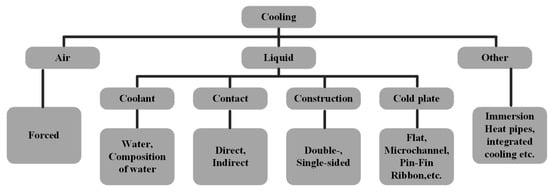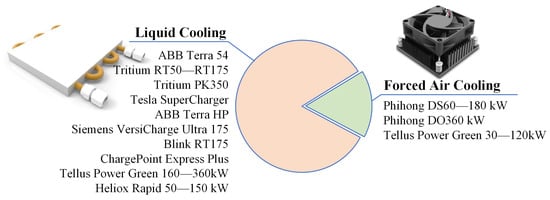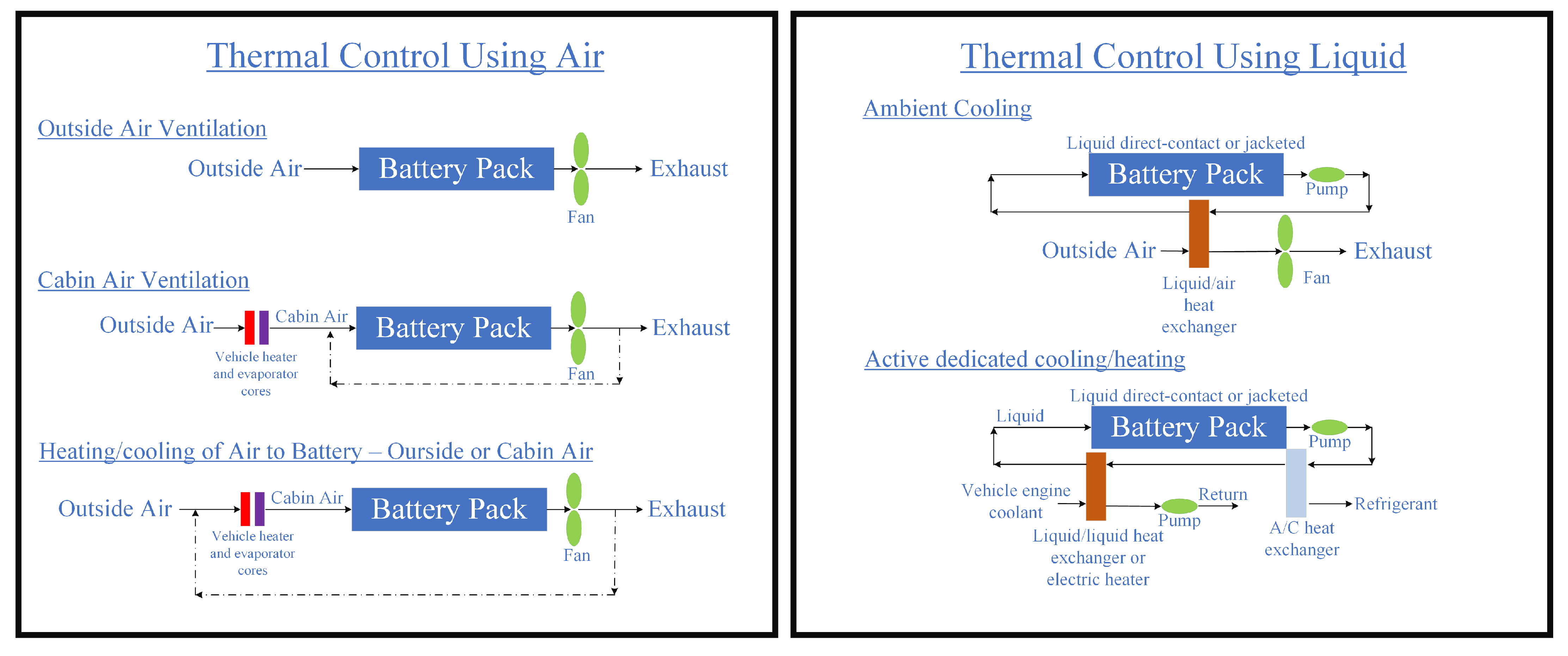The global promotion of electric vehicles (EVs) through various incentives has led to a significant increase in their sales. The prolonged charging duration remains a significant hindrance to the widespread adoption of these vehicles and the broader electrification of transportation. While DC-fast chargers have the potential to significantly reduce charging time, they also result in high power demands that the grid and hence may require local battery energy storage systems (BESS) for peak shaving applications. A high power demand also creates high losses and cooling methods play an important role in overall efficiency, sound pollution, system size, reliability, and lifetime of the system.
- EV DC-fast charging
- battery energy storage system (BESS)
- EV charger topology
1. Power Electronics Cooling Methods


| Advantages | Disadvantages | |
|---|---|---|
| Air Cooling | • Low cost • Does not need additional equipment like heat-exchanger, pump,.. • Active control of fans allow control of junction temperature |
• Performance depends on the environment. • Requires CFD analysis for complex systems. • Can be bulky for high-power applications. • Harder to achieve high IP ratings due to polluted air. • High operation noise. • Fan reliability effects the overall lifetime. |
| Liquid Cooling | • Higher efficiency • Heat removal from enclosed system is easier • Less space and lighter system • Low operation noise |
• Requires CFD analysis for proper channel design • Required pumps, heat exchanger ext. |
2. Stationary and EV Battery Cooling Methods
2.1. State-of-the-Art Cooling Methods for Local BESS and EV Batteries

| Thermal Control Using Air | Thermal Control Using Liquid | |
|---|---|---|
| Advantages | Waste heat released to air No separate cooling loop No leakage concern No electrical short-circuit due to leakage Simple design and lower cost Easier to maintain |
Pack temperature is more uniform and thermally stable Good heat transfer capability Better thermal control Lower pumping power Lower volume Compact design |
| Disadvantages | Low heat transfer capability More temperature variation in the pack Might influence cabin temperature Potential of venting battery gas to cabin High blower power Blower fan noise |
Additional components Higher weight Liquid conductivity can lead to isolation loss Leakage potential Higher maintenance Higher cost |
2.2. Smart Pre-Conditioning Methods for Battery Charging for Improved Lifetime
-
The development of advanced algorithms and machine learning techniques for predicting and optimizing the charging process, in order to minimize stress on the battery and maximize its capacity and longevity [13].
-
The development of improved understanding of the effects of different charging protocols, such as the constant current/constant voltage (CC/CV) charging, pulse charging, and others, on the performance and lifetime of the battery [14].
-
Studying the interactions between different factors that affect battery charging, such as temperature, state of charge, and charging rate, in order to develop more sophisticated models and algorithms for optimizing the charging process [15].
-
Testing and evaluating smart pre-conditioning in different battery chemistries and applications, such as lithium-ion batteries for electric vehicles, stationary energy storage systems, and portable electronic devices.
-
Integrating smart pre-conditioning into commercial battery charging systems, in order to demonstrate its benefits and potential for real-world applications.
This entry is adapted from the peer-reviewed paper 10.3390/batteries9020121
References
- TIDA-01606. 10-kW, Bidirectional Three-Phase Three-Level (T-type) Inverter and PFC Reference Design. 2021. Available online: https://www.ti.com/lit/ug/tidue53h/tidue53h.pdf?ts=1675664546647&ref_url=https%253A%252F%252Fwww.google.com%252F (accessed on 17 November 2022).
- Chen, B.; Liang, X.; Wan, N. Design Methodology for Inductor-Integrated Litz-Wired High-Power Medium-Frequency Transformer with the Nanocrystalline Core Material for Isolated DC-Link Stage of Solid-State Transformer. IEEE Trans. Power Electron. 2020, 35, 11557–11573.
- Stojadinovic, M.; Biela, J. Modelling and Design of a Medium Frequency Transformer for High Power DC-DC Converters; Institute of Electrical and Electronics Engineers Inc.: Piscataway, NJ, USA, 2018; pp. 1103–1110.
- Abramushkina, E.; Zhaksylyk, A.; Geury, T.; Baghdadi, M.E.; Hegazy, O. A thorough review of cooling concepts and thermal management techniques for automotive wbg inverters: Topology, technology and integration level. Energies 2021, 14, 4981.
- Zhao, G.; Wang, X.; Negnevitsky, M.; Zhang, H. A review of air-cooling battery thermal management systems for electric and hybrid electric vehicles. J. Power Sources 2021, 501, 230001.
- Wang, X.; Liu, S.; Zhang, Y.; Lv, S.; Ni, H.; Deng, Y.; Yuan, Y. A Review of the Power Battery Thermal Management System with Different Cooling, Heating and Coupling System. Energies 2022, 15, 1963.
- Wu, W.; Wang, S.; Wu, W.; Chen, K.; Hong, S.; Lai, Y. A critical review of battery thermal performance and liquid based battery thermal management. Energy Convers. Manag. 2019, 182, 262–281.
- Wazeer, A.; Das, A.; Abeykoon, C.; Sinha, A.; Karmakar, A. Phase change materials for battery thermal management of electric and hybrid vehicles: A review. Energy Nexus 2022, 7, 100131.
- Lamprecht, A.; Garikapati, A.; Narayanaswamy, S.; Machleid, J.; Steinhorst, S. On the efficacy of SoC-preconditioning on the utilization of battery packs in Electric Vehicles. Microprocess. Microsyst. 2022, 88, 103711.
- Bui, T.M.; Sheikh, M.; Dinh, T.Q.; Gupta, A.; Widanalage, D.W.; Marco, J. A Study of Reduced Battery Degradation through State-of-Charge Pre-Conditioning for Vehicle-to-Grid Operations. IEEE Access 2021, 9, 155871–155896.
- Lin, X.; Khosravinia, K.; Hu, X.; Li, J.; Lu, W. Lithium Plating Mechanism, Detection, and Mitigation in Lithium-Ion Batteries. Prog. Energy Combust. Sci. 2021, 87, 100953.
- Chen, S.; Bao, N.; Garg, A.; Peng, X.; Gao, L. A Fast Charging–Cooling Coupled Scheduling Method for a Liquid Cooling-Based Thermal Management System for Lithium-Ion Batteries. Engineering 2021, 7, 1165–1176.
- Kleiner, J.; Stuckenberger, M.; Komsiyska, L.; Endisch, C. Advanced monitoring and prediction of the thermal state of intelligent battery cells in electric vehicles by physics-based and data-driven modeling. Batteries 2021, 7, 31.
- Lee, C.H.; Wu, Z.Y.; Hsu, S.H.; Jiang, J.A. Cycle Life Study of Li-Ion Batteries with an Aging-Level-Based Charging Method. IEEE Trans. Energy Convers. 2020, 35, 1475–1484.
- Gao, Z.; Xie, H.; Yang, X.; Niu, W.; Li, S.; Chen, S. The Dilemma of C-Rate and Cycle Life for Lithium-Ion Batteries under Low Temperature Fast Charging. Batteries 2022, 8, 234.
